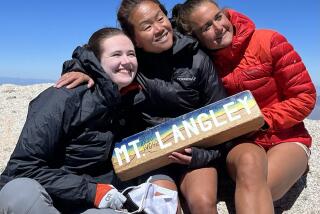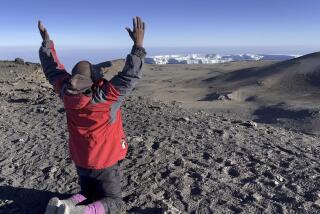Martina Navratilova’s toughest foe was a mountain of trouble
Martina Navratilova has reached the summit of her sport 59 times. That represents 18 Grand Slam event titles in singles, 31 in women’s doubles and 10 in mixed doubles.
But last week, she found a mountain tougher than Steffi Graf’s forehand or Billie Jean King’s slice serve. It stands 19,341 feet and is named Kilimanjaro.
“I had no pain,” she said Sunday, “but I had to retire from my match.”
She was speaking by telephone to a handful of reporters around the world. She said she was sitting in the garden at a friend’s home in the Nairobi, Kenya, suburb of Karen.
“I’m just relaxing here,” she said. “One of the local dogs is next to me. I’m reading a book called ‘Cutting for Stone.’ I was going to read it on my climb, but there was no chance for that.”
No chance, indeed.
One of the better tennis players ever is also a member of the Laureus Sport for Good Foundation. It is a group of 50 or so elite athletes from around the world, led by former Olympic track star Edwin Moses, who raise money for humanitarian causes and donate their time.
Navratilova’s donation this time was to lead a group of 27 to the top of Kilimanjaro and raise more money for Laureus. Kilimanjaro is among the more accessible of the world’s peaks. It is more hiking than technical challenges or rock ascents. The success rate, therefore, is higher, but an average of 10 people per year die on the climb.
At nearly 20,000 feet at the top, it is not much below a normal cruising altitude for commercial airplanes. When not protected by an airplane fuselage, bad things can happen to the human body at that altitude.
Navratilova, at 54 still only four years removed from her most recent major title in the U.S. Open mixed doubles and only eight months past breast cancer surgery, had a bad thing happen. It is called pulmonary edema, which is excessive fluid in the lungs.
“We began climbing Monday,” she said. “Immediately, it started to rain, then snow. It was foggy. I brought binoculars and never used them. It was so bad that I got lost trying to find my own tent at base camp.
“This was supposed to be fun, but nobody had fun. It was just survival. It is not an experience one would enjoy.”
And that was before she got sick.
“I had some bad fish on Sunday before we left, so I didn’t feel that well when we started,” she said. “But pretty soon, I had difficulty breathing. I’d struggle to get enough energy to walk. You don’t move fast up there, anyway. You kind of shuffle along like old folks. But I was even slower.”
She thought her stomach problems would ease, allowing her to go on. She had trained hard after her cancer surgery and the ensuing radiation treatment and got herself into top shape. The thought of quitting never occurred to her on the tennis court, and she wasn’t happy that it was on the mountain. But by Wednesday, she knew she probably would not make it. She wrote that in her diary, then cried and stopped writing.
“Nothing hurt,” she said. “It was not like anything else in my life. But I knew I couldn’t make it.”
A doctor tested her oxygen saturation at 62. Normal is about 98.
Thursday afternoon, they took her down the mountain on a rolling stretcher. From the medical center at the base, she was flown to a hospital in Nairobi and diuretics quickly reduced the fluids in her lungs. She saw X-rays, listened to doctors and slowly began to realize that, while her situation probably wasn’t life-threatening, it could have been had she soldiered on.
“I was lying in the hospital, watching TV,” she said, “and a crawl came across on CNN. It said, ‘Ailing Navratilova Quits Kilimanjaro.’ They made it sound like I had a choice. My choice was to keep going up and die.”
Navratilova was to return to the States on Monday. She said she is fine. She said that she is proud that much of the money hoped to be raised has been — 18 of the 27 in the starting party made the top — and that donations continue via the Laureus website.
She was asked whether she’d consider trying the climb again.
“It’s not on my bucket list,” she said.
More to Read
Go beyond the scoreboard
Get the latest on L.A.'s teams in the daily Sports Report newsletter.
You may occasionally receive promotional content from the Los Angeles Times.







